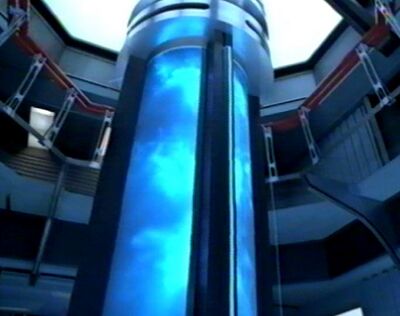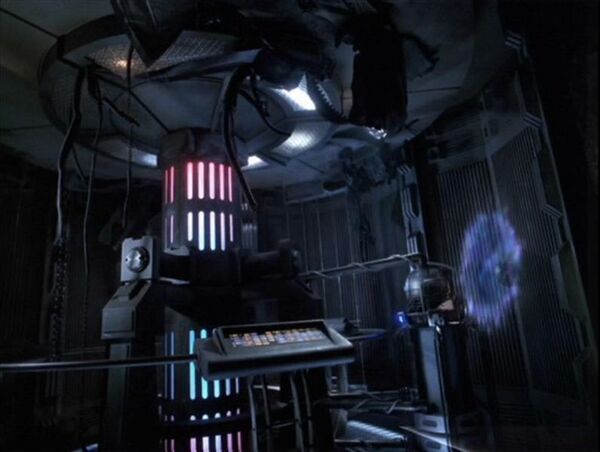Warp Drive
Warp drive is a technology that allows space travel at faster-than-light speeds. It does this by generating warp fields to form a subspace bubble that envelops the starship, distorting the local spacetime continuum and moving the starship at velocities that exceed the speed of light. These velocities are referred to as warp factors.

The main propulsion system for most starships. The core of the warp drive uses dilithium crystals to control the annihilation of matter and antimatter. This controlled explosion is what generates the tremendous power required to warp space and travel faster than light. Warp drive was invented in 2063 by noted scientist Zefram Cochrane.
It is one of many jobs of Engineers onboard a Federation starship to make sure the ship's warp drive is running correctly.
Warp drive is by far the most widespread method of faster than light travel used in the alpha quadrant. Invented in 2063 by Zephram Cochrane of Earth (and later of Alpha Centuri).
Humans subsequently sold warp drive ships to many other cultures, and this technology has become common within the quadrant with over 2,000 species using it. The present day state of the art is not fundamentally different from Cochranes original system; ships today generally use Matter / Antimatter reactors rather than Fusion ones, and dilithium has allowed far higher efficiencies. The Warp Coils themselves have also become more numerous and complex in design.
For the future, many developments are possible. Over a century since it was first envisaged, transwarp drive remains seemingly just beyond the reach of Federation science. other lines of research involve co-axial warp cores, which allow instantaneous travel over sizeable distances, and slipstream technology, which could theoretically allow travel at hundreds of light years per second. If this latter technology ever came to pass, it would make travel on an intergalactic scale easily feasible. On the other hand, the idea of generating stable artificial Wormholes for interstellar travel is also being researched and if successful this may render Warp Drive totally obsolete.
Technology[edit]
24th century Federation warp engines are fueled by the reaction of matter (deuterium) and antimatter (antideuterium), mediated through an assembly of dilithium crystals, which are nonreactive with antimatter when subjected to high-frequency electromagnetic fields. This reaction produces a highly energetic plasma, called electro-plasma or warp plasma, which is channeled by plasma conduits through the Electro-plasma system (EPS). The electro-plasma is funneled by plasma injectors into a series of warp field coils, usually located in remote warp Nacelles. These coils are composed of verterium cortenide and generate the warp field.
Other civilizations use different power sources, such as the Romulans' use of artificial quantum singularities to power their warp drives, but the basic process is similar. In some vessels, such as the Intrepid-class, the nacelles are mounted on variable-geometry pylons.
Parts of the system[edit]

- Antimatter Containment
- Antimatter Inducer
- Antimatter Injector
- Antimatter Relay
- Bussard Collector
- Deuterium Cartridge
- Deuterium Injector
- Deuterium
- Dilithium Articulation Frame
- Dilithium Chamber Hatch
- Dilithium Crystal Chamber
- Dilithium Crystal
- Electro-plasma
- Emergency Shutdown Trip
- Magnetic Interlock
- Main Stage Flux Chamber
- Main Stage Flux Chiller
- Matter Injector
- Matter-Antimatter Reaction Assembly
- Nacelle
- Nullifier Core
- Phase Inducer
- Plasma Conduit
- Plasma Coolant
- Plasma Flow Regulator
- Plasma Injector
- Plasma Intercooler
- Power Transfer Conduit
- Power Transfer Grid
- Pre-Stage Flux Chamber
- Pre-Stage Flux Chiller
- Primary Coolant Tank
- Secondary Coolant Tank
- Space Matrix Restoration Coil
- Theta-matrix Compositor
- Variable-compression Nozzle
- Warp Coil
- Warp Core
There are two distinct fuel storage systems on board any starship; the matter storage is generally a single large fuel tank holding a large amount of slush Deuterium- in the case of the Galaxy Class there is 62,500 m3 of actual Deuterium within 63,200 m3 of tankage space - the rest being accounted for by internal compartmentalization of the fuel tank. The ship thus carries 12,500 metric tons of fuel, sufficient for a mission period of three years assuming normal use of warp and impulse drive, orbiting of planets, etc.
The antimatter is contained within much smaller pods; the standard starship antimatter pod is capable of holding 100 m3 of fuel for a total of 3,000 m3 in a Galaxy class Starship. Starfleet is somewhat reticent about revealing exactly how much antimatter is kept on board its starships, as this would allow threat forces to make detailed estimates of the total output of a ships power systems. It is known that the antimatter used in the Galaxy class is antihydrogen, and that it is kept stored within magnetic fields. In the event of a systems failure which threatens antimatter containment, the pods can be thrown clear of the ship by emergency systems of considerable reliability.
Fuel from the pods is sent to the reactant injectors; these are designed to condition and feed streams of matter and antimatter into the warp core. The matter reactant injector is located at the top of the warp core; it is a conical structure some 5.2 metres in diameter and 6.3 metres high. The injector is constructed of dispersion strengthened woznium carbmolybdenide. Shock attenuation cylinders connect it to the deuterium fuel tank and the skeletal structure of the ship, allowing it to 'float' free within the structure.
Within Starfleet vessels, the MRI contains redundant sets of crossfed injectors. Each injector would consists of a twin deuterium manifold, fuel conditioner, fusion pre-burner, magnetic quench block, transfer duct/gas combiner, nozzle head, and related control hardware. other designs are in use by civilian craft and other species. Although operation varies from class to class, in general slush deuterium enters the inlet manifolds and is passed to the conditioners where heat is removed. This brings the deuterium to just above solid transition point; micropellets are formed and then pre-burned by a magnetic pinch fusion system. The fuel is them sent on to a gas combiner where it reaches a temperature in the region of 106 K. Nozzle heads then focus the gas streams and send them down into the constriction segments.
Starfleet safety protocols require that should any nozzle fail, the combiner can continue to supply the remaining nozzles which would dialate to accomodate the increased fuel flow. The present generation of nozzles are constructed of frumium-copper-yttrium 2343.
The antimatter injector lies at the lower end of the warp core. Its internal design is distinctly different from that of the matter injector owing to the dangerous nature of antimatter fuel; every step in manipulating the antihydrogen must use magnetic to keep the material from Physically touching any part of the structure. In some ways the ARI is a simpler device requiring fewer moving components. It uses the same basic structural housing and shock attenuation as the matter system, with adaptions for magnetic suspension fuel tunnels. The structure contains three pulsed antimatter gas flow separators; these serve to break up the incoming antihydrogen into small manageable packets and send them up into the constriction segments. Each flow separator leads to an injector nozzle and each nozzle cycles open in response to computer control signals. Nozzle firing can follow highly complicated sequences resulting from the varying demands of reaction pressures and temperatures and desired power output, amongst other factors.
The magnetic constrictors make up the bulk of the warp core. They provide Physical support to the reaction chamber, pressure containment for the whole core and, most importantly, guide and align the fuel flow onto the desired location within the reaction chamber.
The matter constrictor is typically longer than the antimatter constrictor, as antimatter is easier to focus and so requires a shorter distance for the same accuracy. Typically, the magnetic constrictors are divided into segments; each segment will contain several sets of tension frame members, a toroidal pressure vessel wall, several sets of magnetic constrictor coils and related power and control hardware. Constrictor coils will have dozens of active elements, and on more advanced designs these will be configures to contain the magnetic field almost wholly within the constrictor, with minimum spillage into the exterior environment. Starfleet warp cores usually have the outermost layers of the constrictors constructed of a semi-transparent layer which allows harmless secondary photons to escape from the inner layers, creating a glow effect. This gives an immediate visual cue to the current activity rates within the warp core.
As the fuel is released from the injector nozzles, the constrictors compress it and increase the velocity considerably. This ensures the proper collision energy and alignment within the reaction chamber.
This is in many ways the "heart" of the ship. The principle function of any reaction chamber is to allow the matter and antimatter streams to come together and direct the resultant energy flow into the power transfer conduits. This apparently simple task is rendered highly complex by the need to allow the various sensor and other monitoring and control equipment to function within the chamber. The addition of dilithium to regulate and control the reaction, while allowing far higher efficiency and so increasing the power output, has also lead to ever more complex designs - most especially in more recent starships which are designed to allow continual recompositing of the dilithium whilst in use. Nevertheless, reaction chambers of today perform fundamentally the same task as those of a century ago or more.
The power transfer conduits are similar in nature to the magnetic constrictors of the warp core, in that they are ducts designed to use high energy magnetic fields to carry energetic plasma from one point to another. But where the magnetic constrictors operate only across relatively short distances and require a very high degree of precision with a comparitively low energy plasma, the PTC's must carry very energetic plasma across large distances with - relatively speaking - far less finesse.
Federation starships are equipped with a separate PTC line for each nacelle, a measure which increases resistance to battle damage or other failures. Since most Starships have twin nacelles, two PTC's will typically be arranged to be symmetrical about the ships centreline. These will proceed through the bulk of the engineering hull and along the connecting struts, if any, to the nacelles themselves.
Smaller versions of these heavy duty systems are also used to carry power to components such as the phasers, shields, and high energy scientific laboratories.
At the terminus of the Power Transfer Conduits are the plasma injectors. One of these devices is fitted in each nacelle, and has the task of sending a precisely aimed plasma flow through the centre of the warp coils.
Because of the relatively low accuracy with which the plasma flow is usually controlled by a PTC, the plasma injector system must often be designed to re-condition the fuel flow in order to dampen down turbulence and so ensure a smooth flow through the warp coils. In many Starfleet designs, most especially those systems with the highest raw power output, the plasma flow from the PTC is split into two parts and sent through swirl dampers before being recombined during the injection process. Long experience has found that this method reduces the size of the required hardware to a reasonable minimum.